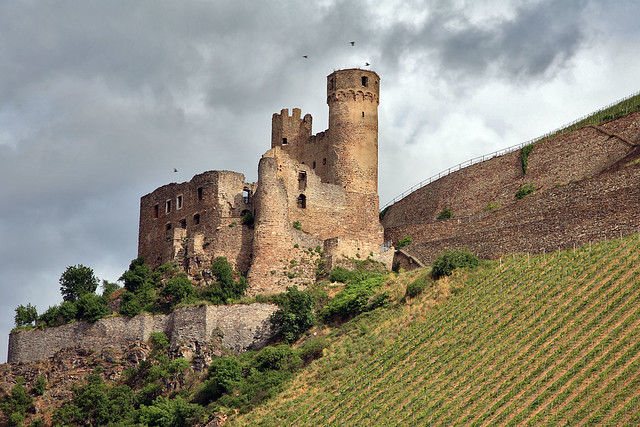
Burg Ehrenfels, near Bingen
[ < < previous | index | next >> ]
We got up early for a bright start to a long and busy day, and have just returned to the hotel and cleaned up for an early night because we have an even earlier morning tomorrow so that we can get to Frankfurt Airport in time for our flight home.
After breakfast we walked down to the Rhine to get a KD-Line ferry down the river. We made it there about 09:15, and the next ferry was at 09:30. In fact, it was the first of the day, and the timetable showed only six ferries running all day, some with two or three hour gaps in between. Accordingly, we ditched our first planned stop at Bacharach to give us more freedom in planning the day ahead with the limited number of ferry connection options.
 Burg Ehrenfels, near Bingen |
Our first stop became the village of St Goarshausen, on the east bank, across from its bigger sister St Goar. The trip along the river on the ferry Lorelei was slow and stately, but the weather was changeable and somewhat unfriendly, with strong wind gusts driving most people below decks and sending plastic chairs flying along the exposed upper deck. The view was worth braving the conditions for though, with marvellous vistas of the river carving its way deeply through the uplifted and titled slate rock of the countryside, which was covered with a patchwork of forest, vineyards, picturesque riverbank towns snuggled along the narrow banks, and looming castles hovering on hilltops far above the river.
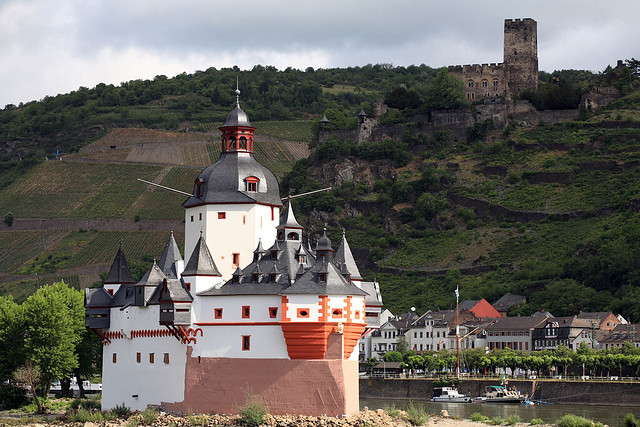 Burg Pfalzgrafenstein |
A large group of Japanese tourists were on the top deck when we boarded, but almost all of them abandoned it when the wind really started to blow. A brief sprinkle of rain took care of the rest. The wind died right down when we reached Bacharach and an equally large number of Americans boarded, immediately heading to the top deck and taking position in chairs in prime wind and rain locations. I was looking forward to seeing them all run for cover as soon as the ship started moving into the middle of the river again.
The weather stayed relatively calm however, giving us a good view of the ongoing scenery along the river. Large tour groups of Japanese and Americans disembarked at St Goar, which looked incredibly touristy from the boat. We stayed on for the quick crossing to the other side of the river, which was achieved by spinning the vessel 180° so it faced upstream and docked with the same side against the dock as on the other bank. This tricky manoeuvre complete, we alighted in the much smaller town of St Goarshausen, which looked to have virtually no shops, let alone tourist facilities.
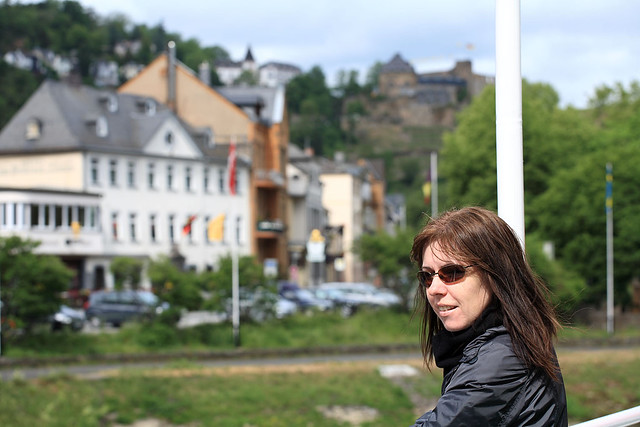 Approaching St Goar |
The first order of business was to find toilets, which we located down a street across the road from a schoolyard full of noisy teenagers, with the help of a woman at a kiosk near where the boat landed. Pleasantly refreshed, we decided to walk to the famed Lorelei rock, rather than attempt to catch a bus. As we walked through the town, we passed a cafe where Michelle got a cappuccino to take with us. A few doors down was a bakery, where we bought three assorted bread rolls for lunch a bit later. The town petered out after that, with just some houses on the narrow strip of land between the road and the railway line - on the other side of the road was the river, and on the far side of the train line was steep slate hillside - there wasn't room for two parallel streets running through the town.
 Lorelei statue, St Goarshausen |
Once the houses run out, we were walking between the river and the rail line for about 1.5 kilometres. The disturbing part was walking on the narrow footpath on the right side of the road and having traffic pass us closely from behind. Part of the way along, we saw the bronze Lorelei statue sitting at the end of a long spit of land running parallel to the bank and connected at the far end. The statue is of a naked woman - a siren - sitting draped on a rock and looked somewhat larger than life-sized. We never bothered to go up close to it, since the spit of land it was one was several hundred metres long and it would have taken a considerable amount of time just to walk out and back.
Near where the spit joined the bank was a lonely kiosk and the bottom of a series of steps leading up the steep hillside. The steps switchbacked a few times along the way up through the trees and were slightly treacherous with small chunks of slate weathered from the rocks above scattered over them, providing a serious possibility of sliding underfoot - as attested by numerous scratch marks in the concrete. We managed to avoid mishap and paused on the way up to eat one of the bread rolls - a flour-coated affair that was similar to a small damper, but with unbleached flour.
 View of Rhine looking north from the top of Lorelei rock |
When we finally reached the top, some 105 metres above the river (a greater height than we'd climbed in the Cologne cathedral) we reached a carpark with a couple of tour buses in it and a restaurant/cafe inside which dozens of Japanese tourists were having tea. We walked over to the lookout knowing we had earned the full experience, unlike the cheap thrills the bus tourists would get after their luxury meal. The lookout points were extremely windy - "but at least it's not raining" - a phrase that would become our mantra throughout the day (at least until it started to rain).
The view, however, was entirely worth it, with a panoramic vista over the Rhine valley, both downstream and upstream, the river winding its way through the deeply cut slate and on the plateaus above views of farmland and a few houses scattered picturesquely across it. We tried to get someone to take a photo of us, but with the dreadful wind and what we would have looked like in it, it was perhaps a good thing that the woman Michelle asked failed to actually press the shutter button hard enough not once, but twice. The view downriver included the river towns of St Goar and St Goarshausen and the castle of Burg Katz sitting on the hill above the latter. Together with numerous barges plying the waterway, the whole was extremely scenic. We walked around the Lorelei rock to the viewpoint looking upstream, which was more wildernessy, and if anything a bit less scenic because of it.
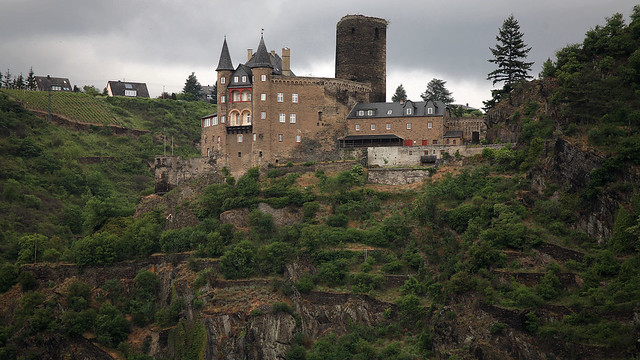 Burg Katz |
After a while the Japanese emerged from their cosy cafe to have a look around. One lady tripped and fell on the uneven slate rocks that stuck up at weird angles in some places between the more flat paving, but she appeared okay after a while. Having had enough of the view and the howling wind, we wended our way back down the steps to the road below by the river and walked back along it to St Goarshausen.
Since we'd passed the two hour limit to get another ferry further downstream for a second stop and now had a three hour wait for the next one, we decided to cross over to St Goar on the back-and-forth car ferry and explore its more likely looking delights until then. The car ferry made the short trip across to the opposite bank every eight minutes, so we didn't have long to wait. We bought our tickets on board and when the guy asked "return or one-way" in German I understood him and answered "Einfach bitte". The ferry did a bizarre twist and rotation as it manoeuvred across the current, and I suddenly realised that it wasn't as simple as pointing the front end of the boat where you wanted to go when you were dealing with crossing a river. The ferry landed us at a spot a short walk from looked like the main tourist drag.
 Burg Rheinfels, over St Goar |
Michelle went in the first souvenir shop she saw and when I followed a woman inside was preparing some free peach brandy for us to taste. I had the small sip from the shotglass; it was very peachy and quite nice. I actually considered buying a small bottle on the strength of this, but it wasn't cheap and I didn't really want to carry it all the way home. Michelle found a cool porcelain teabag dish with a map of the Rhine on it though, and bought that as a gift for her brother. We continued walking up the main street, at the far end of which we could see our goal - Burg Rheinfels - the largest castle on the Rhine and according to the Lonely Planet a "must see". (If we added up all the "must see" places, near our travel route we would have needed six months to see them all!)
We stopped at a bakery intrigued by some chocolate covered blocks and shapes in the window. Having finished our bread rolls on the long trek to and from Lorelei, we felt a bit snacky. Michelle liked the look of a nut-something with a layer of chocolate on the bottom, while I was intrigued by the completely chocolate-coated triangular prisms that bore an interesting local name that eludes me now (Rheinfels-something). We bought one of each and then Michelle used their toilet in the attached cafe before we fled with our sugary goodies. Mine was rather like a lamington really, only without the coconut. Michelle's was a shortbread base with a nutty chewy caramelly topping. She had half of it and I finished it off.
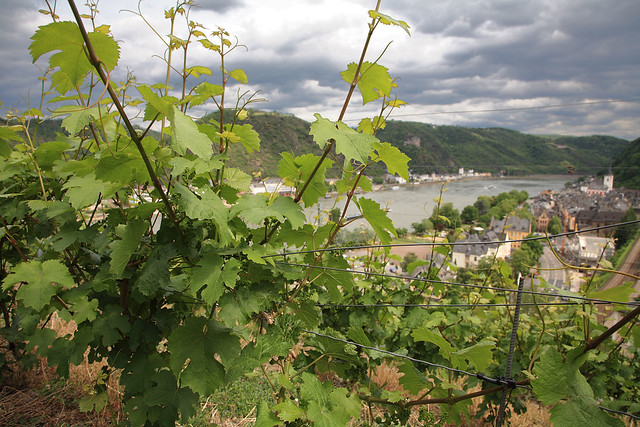 Grape vines over the Rhine at St Goar |
Charged with energy, we tackled the steps up the hill to Burg Rheinfels - since we hadn't climbed nearly enough steps on the trip so far - especially in the last few days. They wound their way up a steeply terraced vineyard until we emerged in the carpark of the hotel now housed in the more intact part of the castle (mega-expensive, you can bet, with views over the Rhine like we could see from there). We walked around to the public entrance to the ruined part of the castle, which looked amazing with half-crumbled remains revealing passages and rooms in the rock walls, windows, and other intriguing shapes. The view from here was again magnificent. We used the toilets - which was an amazement in itself as they were carefully decorated in a faux-medieval theme with giant wooden handles to pull to flush them and an iron well-head pump with a handle you actually had to pump up and down to get water for handwashing, and above one of the urinals a guillotine blade poised to slice in an unmentionable manner.
 Detail of roof of Burg Rheinfels |
Unfortunately we had not the time to enter the ruins and explore further, as we wanted to catch the next ferry the rest of the way down the river as far as Koblenz to see all the sights along the way - a two hour and fifteen minute trip, and it was approaching 16:00 already. So we walked back down the stairs (still not enough stairs on the trip) and through town, detouring very briefly to poke our noses in a church that looked darkly imposing from the outside, but turned out to be nothing special inside. Michelle also stopped for a look inside a shop that boasted the "largest hand-carved free-standing cuckoo clock in the world", which was hanging over the door as a giant sign above the street.
Back at the KD wharf we waited the few minutes for the next ferry to arrive - the Stolzenfels - which was larger than the Lorelei and had separated front and rear open decks on top. With the wind and the number of people camped on the front deck, we set up on the relatively empty rear deck. Michelle grabbed a seat near the door to the interior deck, which was under shelter and had a warm draught from the inside wafting over it, while I braved the elements by walking from side to side to take photos of various cool bits of scenery. First up on the right was Burg Maus, the smaller castle just out of St Goarshausen and companion to the larger Burg Katz. More castles appeared on the riverside hills - most of them apparently built by robber barons to watch over the rivers and extort tolls from passing shipping. They would stretch iron chains across the river to prevent ships from passing until they had paid.
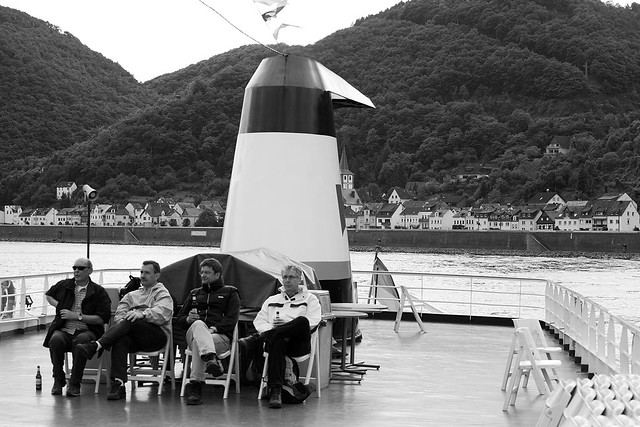 Rugged up with beers for the cruise |
A total of seven more castles graced the slopes of the Rhine valley over our next two hours of cruising gently along it, passing barges of all sizes from small ones carrying loads of scrap metal to giant ones that looked ocean-worthy laden with 100 or more shipping containers. At one point a barge full of heaps of coal passed us, and an American woman said in a loud voice to her friend, "What's that, coal? What do they use that for?" I felt like replying along the lines of that TV ad for cranberry juice with the two California valley girls in it - "Like, you drink it."
 Town of Boppard |
We passed the sister ship Lorelei that we'd taken earlier in the day, returning on its way back up river. We also passed the castle after which our current boat was named: Schloss Stolzenfels - a spectacular orange-yellow painted bastion not far from Koblenz, with a dark stone gothic chapel jutting out from the cliff face towards the river and capped by twin spires. Another highlight was Marksburg castle, on the top of an isolated hill relatively close to the river, the best preserved of all the medieval castles along the river. Although the weather was chilly and windy, four guys spent the whole time from St Goar to Koblenz sitting in a line on the open rear deck, swigging beer to stave off the elements.
We reached Koblenz and the first bridge over the Rhine just after 18:00. We planned to get the 20:20 train back to our hotel in Bingen, filling the time in between with dinner. Having no map of Koblenz, and it being citylike in size, we wandered aimlessly along the riverside touristy eateries until we found a bus stop with a map - but it turned out to be a stylised route map, not a street map. The Lonely Planet said only that the Altstadt was in off the river a bit, so we turned inland up what looked a reasonably major street and just kept walking until we hit some shops. We stumbled on to a square which had a touristy information place on it, which was miraculously open to 19:00. So we went in and quickly scored a free map of the city.
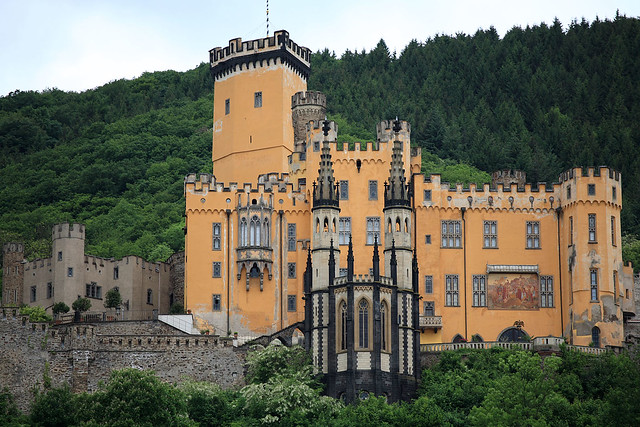 Schloss Stolzenfels, near Koblenz |
We were basically headed in the right direction, so kept going, looking for somewhere decent to eat. Again, however, the tendency for the shopping district to be full of shops and contain little to nothing in the way of food fulfilled itself again, and it wasn't until we turned towards the Hauptbahnhof and left the shops behind that we encountered some restaurants. We spotted a steakhouse/pizzeria named El Toro, and decided that would do. The place had a Spanish air, but was deserted when we sat down. I ordered a schnitzel "el toro" - which consisted of pork fillets with mozzarella cheese on top, finished with a slightly creamy tomato sauce and chips - while Michelle got a margherita pizza. Six hot rolls came with the meals, looking much like miniature scones - we ate four of them altogether. The food was nothing special, but acceptable. We paid and left for the station and our train.
The timetable I'd seen in the bakery in St Goar said trains left for Bingen at 20 past the hour - and for some reason I didn't realise until right now as I write this that of course that would have been departure times from St Goar, not Koblenz! At the time, I'd stupidly assumed the trains left at 20 past from Koblenz, and when we arrived at the Hauptbahnhof with plenty of time to spare at 19:52 to see that a train had left at 19:51, I couldn't understand why the times were inconsistent. According to the (correct) timetable at Koblenz, we now had a 40 minute wait for the next train to Bingen. However, when we checked the departure board, the 19:51 was still on there and marked as "ca. 20 min später" - running 20 minutes late! So I raced over to buy us tickets and we went up on to the platform to wait. As we watched, the indicator changed from 20 minutes late to a mere 5 minutes late, and the train pulled in! Magically, we'd made it exactly on time for this now only slightly late-running train.
We piled aboard and relaxed, retracing our eleven-hour odyssey down the Rhine by boat on a 50-minute train ride back to our starting point. We arrived back at the hotel just after 21:00, after walking back into town from the Bingen Hauptbahnhof.
We wanted to see if we could check out and pay then and just drop off the key in the morning, as we would have to leave at around 07:00, before breakfast. A large group of aged Germans was staggering back from the Sektfest to our hotel just ahead of us. When we entered after them, one man asked me if we had a room in the hotel, and I replied yes. If we hadn't, I'm not sure what we'd have done, since nobody was at reception, and nobody appeared when we rang the door buzzer. Unable to find anyone, we decided the safest thing was to withdraw enough cash to pay for the room so we wouldn't be stuck unable to use a credit card in the morning. We walked the short distance to a nearby ATM to get the cash, and then turned in early, with alarm set for 06:30. Being the last day of the trip, I had no need to sit up and download photos from my camera to the iPod, so I delayed writing up the day's events until tomorrow, and turned in early.
[ < < previous | index | next >> ]